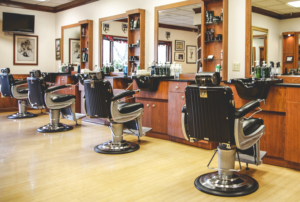Barbershop St George is a four-part harmony style of unaccompanied vocal music. Its defining characteristics are harmonic balance, intonation, and unity, which are achieved through careful word matching and the use of an octave bass clef for the basses.
The LEAD voice sings the melody, while the TENOR part sings above the Lead. The BARITONE part fills in the chords above and below the melody, and the BASS provides a strong harmonic foundation.

Barbershops are more than places for haircuts and shaves; they are vibrant community hubs that foster social connections. Whether through casual chats while getting your hair cut or events organized by the barbers, these unique establishments offer a welcome antidote to our hectic lives. In fact, these establishments can be compared to grooming behaviors in primates, which facilitate intimate and meaningful interactions that support social bonding.
In the broader choral world, most songs are written with a soprano, alto, tenor, and bass (SATB). However, barbershop music is based on the original men’s voicing of Tenor, Lead, Baritone, and Bass. The resulting chords give barbershop music its unique sound. To make the sound more interesting, the barbershop style also includes “tags” and other musical improvised excerpts that can be added to the end of a song. These tags can be taught without sheet music and are a great way for new singers to learn barbershop.
Although the barbershop is a male-dominated organization, female members are also active participants in the music. Sweet Adelines International is the women’s branch of the Barbershop Harmony Society and has over 30,000 members worldwide. They take the art of singing to a new level by combining music with a visual performance. They strive to convey the message of each song while staying true to the harmonies and the structure of the song. They use a variety of styles, from traditional to modern, to present the best possible interpretation of each song.
The barbershop has been a pillar of the community since its inception. Historically, it has been the place where locals gather to voice their opinions and discuss current events. These discussions can be as simple as a quick chat about the weather or as complex as an in-depth political debate. The barbershop has also been a gathering place for community events, such as fundraisers or educational workshops. These events are a great opportunity to promote your barbershop and build relationships with potential customers. The more people hear about your business, the more likely they are to visit it.
It’s a place to get a haircut
A barbershop is a popular place to get a haircut and shave. These salons provide quality cuts in a comfortable environment, and many also offer additional grooming services, such as beard trims, styling advice, and hair coloring. They can be a great place to hang out with friends and meet new people or just relax while you’re getting your hair cut. Choosing a barbershop is a personal decision, and each one offers a different experience.
While salons offer a more contemporary look, barbershops have a more traditional feel and are a hub for men who prefer a classic grooming experience. The vibrant hum of clippers and nostalgic twirl of the barber poles make barbershops a unique social space where you can enjoy the company of other men while getting your haircut. In addition to cutting and shaving, barbershops also offer other grooming services, including beard trimming, hot lathers for shaving, and even facials. Whether you’re looking for a traditional or modern haircut, you can find a barbershop in NYC that offers the look you want.
Barbershop singers are devoted to the idea of brilliant vertical sonority, chords that “lock and ring.” Therefore, dissonance is rarely used in barbershop music. Rather, the barbershop concept of dissonance is more concerned with whether or not a chord sounds good in equal temperament. For example, dominant 7ths sound good in equal temperament, but major and minor 7ths don’t. Likewise, first inversion and third inversion chords are considered dissonant by barbershop singers.
Unlike most choral music, most barbershop songs are sung freely in a rubato style. This allows the melody to be heard more clearly in the top voice and gives a unique and distinctive sound to barbershop singing. Chords are also sung with special harmonies that may be more complex than those written in standard choral scores. In addition, barbershop performers often slow down at cadence points to emphasize certain harmonies and often sing the last few chords longer than the original notation.
If you’re thinking of going to a barbershop for a haircut, be sure to book an appointment ahead of time. This way, you can avoid a long wait and will be able to have a more relaxed and productive experience. Additionally, booking online can save you money as most salons will give you a discount for an advance reservation.
It’s a place to get a shave
If you’re looking for a great shave, nothing beats the traditional barbershop. They’re known for their short cuts and a straight razor, which leaves faces smooth and bump-free. They also offer a variety of hairstyles and trims to suit any type of face shape. They’re a great choice for men who want to keep their hair short but still look stylish. However, some people prefer a salon because of their experience with curly or wavy hair.
In addition to their shaves, barbershops are also famous for their styling skills. They use a combination of hot towels, lather, and a straight razor to create the perfect style for any man. They are also skilled in creating a range of hairstyles, including fades, crewcuts, and side-parts. They can even trim your beard or mustache if you choose.
The barbershop is an old-fashioned environment, with vintage barber chairs and classic poles. It’s a place where you can relax and socialize with friends. Visiting a barbershop is also a great way to get a haircut and shave in NYC without breaking the bank. However, it’s important to choose a barbershop that fits your stylistic preferences. Before you visit, make sure to gather pictures of the style you’re after and discuss it with your barber.
Many modern barbershops have a traditional feel with an emphasis on customer service and quality. The best barbers are able to take the time to listen to their customers and understand their needs. In addition, they’re able to provide expert advice on how to care for your hair. Whether you’re going to the barbershop for a shave or a haircut, it’s important to book your appointment ahead of time. This will ensure that you don’t experience any delays due to overcrowding or unforeseen circumstances.
Barbershop is a musical style characterized by close, four-part a cappella harmony. It was originally improvised by amateur singers, who often performed at parties or picnics. Then, when the printing press was adapted to produce musical notation, the art of barbershop flourished. Today, barbershop is a popular form of entertainment for both men and women.
It’s a place to get a massage
A facial massage is an excellent way to relax, rehydrate the skin, and improve blood circulation. It can also help stimulate hair growth, especially in men, who often experience thinning and balding. Getting a scalp massage at a barbershop is an ideal way to enjoy these benefits in a traditional and masculine environment. It’s also a great way to boost your self-esteem and promote hair health.
In the earliest years of barbershop, amateur singers often improvised harmonies. When the printing press was adapted to produce musical notation, the idiom became more widespread. In the late 1800s, barbershop music remained popular at parties and picnics and in minstrel shows as an interlude between acts. By the turn of the century, radio quartets made close harmony singing even more popular.
The barbershop style of unaccompanied, a capella vocal music is characterized by consonant four part chords that match the melody notes and emphasize the matching of word sounds. It is also characterized by the proper balancing of chords so that overtones are reinforced, giving it its distinctive sound. The Society for the Preservation of Barber Shop Harmony was founded in 1938 to keep this tradition alive.
It is very important to note that barbershop voicings (the chord arrangements used in barbershop) are different from those used in other SATB and SSAA styles. In barbershop, the LEAD voice sings the melody above all other parts; the TENOR part sings the highest note in the chord; and the BARITONE part fills in the all-important missing notes in the chord above and below the melody.
A good lead must be able to sing with authority and clarity while conveying the meaning and emotion of the song. It must also be able to sing with limited vibrato, as too much will prevent the chord from “locking” and “ringing.” The other voices should support the Lead and complement the overall harmony.
A common arrangement in barbershop is TTBB, which works well for both men and mixed groups. This arrangement is typically written in treble clef with an octave bass clef on the bottom, which helps reduce ledger lines.








